Yojana Magazine is an important source of material for the UPSC exam. The monthly magazine provides details of major government schemes and programmes in various domains. Moreover, coming from the government, it is an authentic source of information for the UPSC Exam. Here, we provide the Gist of Yojana, exclusively for the IAS Exam.
TABLE OF CONTENTS
1. Combating COVID-19 2. India’s Response to Covid-19 3. The Vaccine Quest 4. Redefining Science Communication 5. Energy Security: Nuclear Power 6. The Himalayan Floods 7. Geomagnetism: Applications 8. Nanotechnology in Textiles 9. LightHouse Projects 10. Drone Policy 11. Science Education 12. Nutrition and Vaccination 13. TID-BITS
Chapter 1: Combating COVID-19
Introduction
This chapter describes the measures taken by India in response to the Covid-19 pandemic.
- India’s Efforts to Combat COVID-19 – Pillars of India’s Vaccine Policy
- Vaccine Development
- Government – Academia – Industry
- Covishield (Serum Institute), Covaxin (Bharat biotech) – developed in nine months from the declaration of the pandemic.
- Emergence of smaller companies and startups
- PPE and Ventilators
- From acute shortage to being an exporter of PPEs
- Ventilator Project: World-class ventilators are built
- Testing, Tracing and Diagnostics
- Essential tool for COVID-19
- Scaling testing
- Diagnostic development
- FELUDA, Single gene PCR Diagnostics (COROSURE): Know more in PIB dated Sep 19, 2020.
- Therapeutics and drugs
- Four Categories of Drug Development:
- Repurposing
- New chemicals
- Phyto-pharmaceuticals and
- Drugs from traditional medicinal knowledge
- Indian capacity in drug design needs long term investment and supply chain API
- Robust clinical trials
- Four Categories of Drug Development:
- Surveillance and Sero
- Increased transmission can be prevented by Sero surveillance
- Harmonised protocols for virus surveillance
- Genome Sequencing
- Indian SARS-CoV-2 Genomic Consortium (INSACOG)
- Regulation and Regulatory Support
- Need for fast track of conferences
- Concerns with India’s Pandemic Preparedness
- India was unprepared for global trials due to a lack of identified clinical trials
- The procurement system needs to be favourable for indigenously developed products
- India should apply for easy to use tests in global markets
- Indian science and technology needs to synergize with industry
- Political will, governance, partnership of academia and industry with equality and equal access
Chapter 2: India’s Response to Covid-19
Introduction
This chapter explains India’s Efforts in Strengthening Vaccine Development Ecosystem.
What are the Indian Efforts in Strengthening Vaccine Development Ecosystem?
- Clinical trial sites equipped with Good Clinical Practice (GCP) Compliance, robust disease registry.
- Support to immunogenicity labs, Viral Neutralization tests.
- Department of Biotechnology (DBT) autonomous institutes were upgraded as a response to Covid-19.
- Mission Covid Suraksha – the Indian Covid-19 Vaccine Development Mission
- Mission COVID Suraksha is launched under Atma Nirbhar Package 3.0.
- It is India’s specific effort to support the development of indigenous, inexpensive, and accessible vaccinations for the country.
- It will complement Atmanirbhar Bharat’s continuing objective.
- During the third economic stimulus, the Centre announced this plan.
- With its end-to-end focus on preclinical development, clinical development, manufacturing, and regulatory facilitation for deployment.
- Know more about Mission COVID Suraksha in the link.
- Partnership for Advancing Clinical Trials (PACT) Initiative
- This initiative was established to aid the development of COVID-19 vaccines in partner nations.
- The PACT programme is being carried out in collaboration with the Ministry of External Affairs.
- It is part of a joint project by the Department of Biotechnology and the Ministry of External Affairs to build capacity for phase 3 clinical trials of the Indian COVID vaccine in friendly neighbouring nations.
- I-labs:
- India launched the country’s first mobile I-Lab (Infectious disease diagnostic lab) for last-mile coronavirus (COVID-19) testing access.
- National Biomedical Resource Indigenization Consortium
- The Centre for Cellular and Molecular Platforms hosts and leads the National Biomedical Resource Indigenisation Consortium (NBRIC), which is a Public-Private Partnership (PPP) entity.
- The National Biomedical Resource Indigenisation Consortium (NBRIC) was established by the Ministry of Science and Technology’s Department of Biotechnology.
- NBRIC is a ‘Make in India’ project aimed at increasing import substitution and exports via biomedical research and creative goods.
- Indian SARS-CoV-2 Genomics Consortium (INSACOG)
- INSACOG was jointly initiated by the Union Health Ministry of Health, and the Department of Biotechnology (DBT) with the Council for Scientific & Industrial Research (CSIR) and the Indian Council of Medical Research (ICMR).
- It is a consortium of 28 National Laboratories to monitor the genomic variations in the SARS-CoV-2.
- INSACOG is a multi-laboratory, multi-agency, pan-India network to monitor genomic variations in the SARS-CoV-2 by a sentinel sequencing effort.
- DBT-BIRAC
- Biotechnology Industry Research Assistance Council (BIRAC) is a non-profit public sector enterprise, set up by the Department of Biotechnology (DBT).
- It is an Interface Agency to strengthen and empower the emerging Biotech enterprises to undertake strategic research and innovation.
Chapter 3: The Vaccine Quest
Introduction
In this chapter, we will study the evolution of vaccines in India and how India should be vaccine-ready in future.
Challenges of Coronavirus Vaccine:
- The success of vaccines is under threat due to the potential emergence of variants.
- There is a potential threat of new coronaviruses crossing from animals to humans.
- There is large genetic diversity among coronaviruses, which reduces the efficiency of vaccines.
Read more about covid-19 virus variants in the link.
Opportunities in Vaccine Development:
- With the convergence of biomedical, engineering, and computing technologies new vaccines antigens can be developed.
- With machine learning and structural modelling of proteins, we can rapidly develop vaccines.
Solutions:
- Developing Universal Coronavirus Vaccines to protect from variants and also other dangerous coronaviruses in future.
- Planning for the future emergence of viruses can be done through the analysis of genetic sequences.
- For example, Walter Reed Institute in the US has already made a vaccine against SARS-Cov-1 and SARS-Cov-2 in animal studies.
- Nanoparticle-based approach can be used for multiple copies of the receptor-binding domain of the spike protein.
- Two broad immune responses against the virus can be used:
- Antibody Response – Produce antibodies that can recognise many kinds of proteins.
- Cellular Response – Destroy infected cells to limit T-Cells infections.
Chapter 4: Redefining Science Communication
Introduction:
- India’s Science Popularisation agenda is achieved through several two-way stakeholder-specific approaches.
- It serves as a robust knowledge-led tool to fulfil three mutually reinforcing public policy objectives:-
- To create and foster a well-informed citizenry.
- To build capacities to communicate through formal and non-formal systems.
- To lead engagement that follows knowledge enrichment.
How India is Redefining Science Communication
- Scientific Social Responsibility
- Scientific Social Responsibility (SSR) is the intersection of scientific knowledge, visionary leadership, and social consciousness.
- The Science and Engineering Research Board (SERB) is leading the SSR endeavour.
- The SSR strategy seeks to extend the advantages beyond the immediate recipients, particularly to less-affluent researchers.
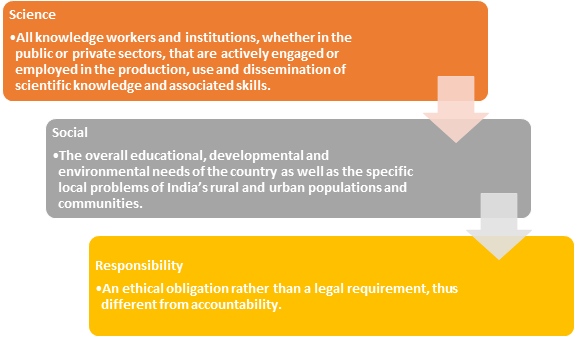
- Constitutional Mandate
- Article 51 A of our Constitution which deals with fundamental duties makes it a duty of every citizen to develop Scientific Temper.
- Vigyan Prasar
- Vigyan Prasar is an autonomous organisation under the Department of Science and Technology that uses physical and multimedia contact points to stimulate the public’s interest in science.
- Significant Programmes by Vigyan Prasar are:
- Science Communication, Popularisation and Extension (SCoPE)
- It is a day-long workshop to review and further plan its flagship science project in Indian Languages (Vigyan Bhasha).
- Project Vigyan Bhasha initiative has unleashed science communication, popularisation and extension in chosen Indian languages.
- The following figure depicts SCoPE Initiatives:
- Science Communication, Popularisation and Extension (SCoPE)
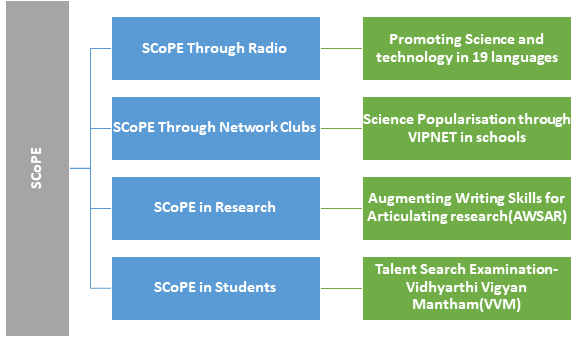
- Science, Technology and Innovation Policy 2020
- STIP 2020 is a comprehensive and practical policy focused on science, technology, and, most importantly, innovation.
- The policy seeks to realign Science, Technology, and Innovation (STI).
- Know more about STIP 2020 in the linked article.
- Foray in Electronic Media
- Two initiatives by Vigyan Prasar:
- DD Science
- India Science
- Two initiatives by Vigyan Prasar:
- Popularising Science in Indian Languages
- Science in Print and Publishing – Dream 2047
- Vigyan Prasar publishes Dream 2047, a monthly popular science magazine.
- Science Film Festivals: ISFFI and NSFFI
- Engage with Science: Interactive platform for teachers and students to make science teaching and learning fun.
- Amateur Radio Stations: Provides technical support and fulfils the informational needs of students.
- Popularisation of Astronomy: EDUSAT for maths popularisation, workshops, Ramanujan Yatra 2020, Pi Day.
Chapter 5: Energy Security: Nuclear Power
Introduction:
In this chapter, we will study how energy drives the economic growth of the country and leads to urbanisation and modernisation. We will also understand the significance of Energy Security for India.
What is Energy Security?
- Energy security refers to the continuous availability of adequate energy in a variety of forms at reasonable rates.
- Energy security, according to the International Energy Agency (IEA), is the continuous availability of energy sources at a reasonable cost.
What is the Significance of Energy Security for India?
- Coal accounts for 55% of India’s energy mix, while renewable energy accounts for 20% and nuclear energy accounts for 3%.
- In India, there is a significant gap between energy demand and energy supply.
- Almost one-third of India’s population is still not linked to any of the country’s five electrical networks.
- India intends to sustain the yearly economic growth of 8%, implying that power demand would rise significantly.
Nuclear Energy for Energy Security in India
India is planning to increase the present share of electricity derived from nuclear power.
India’s Efforts:
- Three stage nuclear power programme: In 1969, India embarked on its commercial nuclear power production. This nuclear power programme was conceived as a closed fuel cycle to minimize nuclear waste. Dr Homi Bhabha, who is regarded as the father of the Indian Nuclear Power Programme, envisioned this programme. The three stage nuclear power programme utilised the country’s vast reserves of thorium-232.
- Nuclear Power Corporation of India Limited (NPCIL): It is a public-sector enterprise in India that was founded in 1987. It is completely owned by the Indian government and is in charge of generating nuclear power for energy.
Why should India invest in Nuclear power to ensure Energy Security?
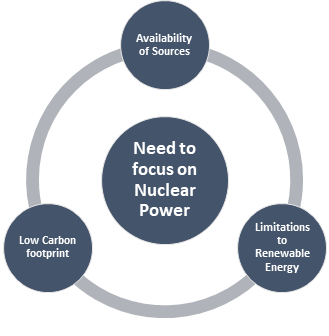
- Availability of Sources: India imports a major portion of its fossil fuels, posing economic and strategic risks. In comparison to fossil fuels, nuclear power assures the availability of sources.
- Low Carbon Footprint: Carbon emissions are expected to grow if the Indian economy continues to rely on coal. This will have an effect on national expenditure on domestic environmental and health initiatives. Thus, nuclear energy is a feasible alternative.
- Limitations to Renewable Energy:
- Renewable energy like solar and wind is land-intensive.
- Besides, it is dependent on imported technology and materials such as photovoltaic cells, batteries, etc.
- There is the issue of energy storage which is unsuitable as a baseload source of energy.
Challenges for India’s Energy Security
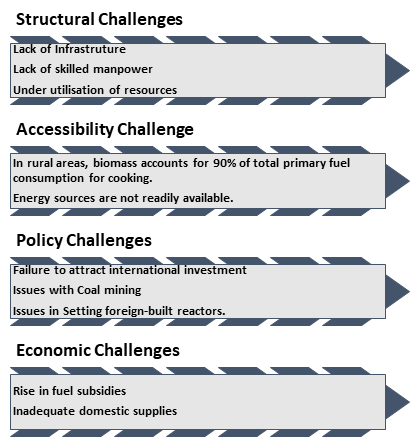
Conclusion:
The Indian economy is dominated by energy-intensive manufacturing and service sectors. India needs to focus on all available sources to ensure Energy Security.
Chapter 6: The Himalayan Floods
Introduction: –
In this chapter, we will analyse the tools of flood monitoring and flood mapping in designing the strategies for flood mitigation and disaster risk reduction.
Himalayas Flood Mitigation and Disaster Risk Reduction
- What is Flood Mitigation?
Flood mitigation is a strategy for lowering the overall risk of flood damage to a structure, as well as the degree of flood damage when it does occur. Flood mitigation strategies are classified into two types: structural and nonstructural.
- Need of Flood Mitigation in the Himalayas:
- The Himalayas are drained by the river Indus in the west and Brahmaputra in the east.
- There is a dramatic increase in the population living in the Himalayan belt due to urbanisation.
- Scientists have predicted significant surface warming trends in the Himalayas.
- Temperature rise will lead to increased precipitation which along with mountain fragility will result in more disastrous conditions.
- Example: Leh floods (2010), Kedarnath Floods (2013), Rishiganga floods (2021)
- Intergovernmental Panel on Climate Change (IPCC-2019) Reports indicate significant concerns:
- An overall increase in the frequency of high-intensity rainfall events in the Himalayas.
- Understanding of extreme hydrological events and their interaction with orography and geology of Himalayas.
- Insufficient flood records have led to inefficient flood mapping. Thus, reconstruction of flood records is needed.
- Read more on the IPCC latest report in the link.
- Causes of Floods in the Himalayas
- Intense rainfall events
- Landslide dammed lake outbursts (LLOFs): LLOfs are analogous with dams being formed by landslides. Examples: Landslide dammed lake of Birahi Ganga (1893-1970); Satluj river devastation in 2000 and 2005.
- Glacier dammed lake outbursts (GLOFs): It is a breach of water bodies that are formed due to damming of streams by surging or advancing glaciers or by impounding hill-slope runoff and snowmelt. Example: Shyok river, 2013 Kedarnath incident. Know more about GLOFs in the link.
- Cloud bursts
- Combination of natural surface processes and rainfall distribution
- Overall geology, orography, catchment-wide distribution of lakes, landslide zone and rainfall.
Flood Mapping
- What is Flood Mapping?
- Flood mapping is the technique of identifying places at risk of flooding on a map.
- It lays the groundwork for effective flood risk management.
- Elements of Flood Mapping
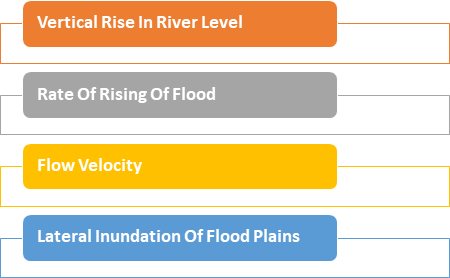
- Strategies of Flood Mapping
- Flood mapping involves precise measurements of flood levels in rivers and streams. This can be done with the Internet of Things (IOT) and radars.
- Parameters such as infiltration, drainage density, gradient and vegetation cover need to be addressed to increase the efficiency of the drainage network.
- Flood level/rate measurement has to be inclusive of data at various levels.
- Slack water deposits that are composed of a centimetre to meter scale couplets of sand and silt represent an individual flood event. The height of these deposits is above river levels which can be used to reconstruct extreme hydrological events.
- The lateral extent of flood inundation can be mapped using satellite images and LiDAR.
- The flood velocities can be measured using current meters, Acoustic doppler current profilers,floaters etc.
- The sediment load of floodwaters can be measured by sediment monitoring gauges or sensors equipped with Laser In-Situ Scattering and Transmissometry sampling.
Way Forward
- Damage Predictive Model of Himalayas: Such models can be prepared by a proper understanding of the orography of the Himalayas and past flood events.
- Landslide and Glacial Lake Monitoring Systems: It should be linked to flood management centres via the Internet of Things.
- Use of Flood Data: A combination of data on flood levels, flood hydrographs, lateral inundation can be used to manage floods and minimise destruction.
- Inundation Maps: Such maps prepared using satellite images or LiDAR can be combined with social infrastructure to obtain predictive models of flood events.
Chapter 7: Geomagnetism: Applications
Introduction:
This chapter examines the impact of Geomagnetism on human lives and also studies its societal applications.
Geomagnetism
- What is Geomagnetism?
- Geomagnetism is the study of the dynamics of the Earth’s magnetic field, which is generated in its core.
- William Gilbert is credited with developing this discipline of research in geomorphology.
- Magnetic Minerals
- Magnetic minerals often include iron oxides, and the greatest example of a magnetic mineral is lodestone, also known as magnetite.
- Magnetic minerals buried in crustal rocks are used to map curie temperature, which is indicative of the magnetic transition zone between the crust and the mantle.
- Applications of geomagnetism:
- To understand regional deformities and the structural framework of the continental and oceanic realm.
- To categorise mineralised zones and geotectonic faults becomes easier.
- To mine a wealth of information regarding the regional geology and tectonic framework of India.
- To understand the climate changes and environmental fluctuations.
- To create aurorae at polar regions when magnetic storms hit the earth.
- To tackle the diaphanous domain of solar winds, an eclectic approach is pursued across the earth’s magnetic field.
- To elucidate the physical mechanisms responsible for generating pulsations and controlling their cross-field transport in the magnetosphere.
- To understand the concept of continental migration by formulating definitions of plate tectonics and seafloor spreading.
Chapter 8: Nanotechnology in Textiles
Introduction:
This chapter describes the application of nanotechnology in the textile industry.
Nanotechnology
- The study of science, engineering, and technology at the nanoscale, which is measured in nanometers, is known as Nanotechnology.
- A nanometre is one-billionth of a metre, or ten times the diameter of a hydrogen atom.
- Nanotechnology has been hailed as having the potential to increase energy efficiency, aid in environmental cleanup, and address serious health concerns.
Nanotechnology in Textiles:
- Desirables of New Generation Clothing:
- Changing lifestyles, pollution, environmental conditions, unexpected challenges such as COVID-19, Thermoregulation, protection from UV light, and electromagnetic field, etc.
- To get rid of bacteria and odour from sweat absorbed by the fabric.
- Applications:
- Nanosilver: It is developed by the International Advanced Research Centre for Powder Metallurgy and New Materials (ARCI). It is a nanosilver based suspension that can be applied on fabric surfaces to get antibacterial activity.
- Application in the medical sector: In present pandemic situations antimicrobial textiles are essential as bed cover, face masks, aprons, etc.
- Sportswear: It can provide the best hygiene in sportswear.
- Technical Textiles:
- Technical textiles are useful fabrics used in a variety of sectors such as vehicles, civil engineering and construction, agriculture, healthcare, industrial safety, personal protection, and so on.
- Example: Fireproof and flame retardant fabric required by firefighters.
- Titanium Dioxide (TiO2):
- It is a strong antimicrobial material that conducts the phenomenon known as “Photocatalysis”. The special feature of ARCI developed titanium dioxide is that it is a ‘self-cleaning’ material.
- The titanium oxide can: absorb ultraviolet rays in sunlight, create highly reactive radicals, keep the surface and surrounding clean.
- The product known as ‘Wearable Sunscreen’ tagged garments in the market is based on the property of titania microspheres.
- Fabric Air Filters: It is a fabric with nanofiber coating used to filter air conditioners and automobile exhaust. Electro-spinning techniques have been used to produce these air filters.
- Thermoregulation: The nanofabric responds to changes in the body temperature and maintains comfort by either heating or cooling. It incorporates Phase Change material (PCM) into the fabric to fulfil this function.
- Limitations of Nanotechnology Applications in Textiles:
- Scientific complexity, more expensive, toxic effects of handling nanomaterial in textiles.
Chapter 9: LightHouse Projects
Introduction:
This chapter explains the concept of LightHouse Projects (LHP) and their significance in government programmes.
LightHouse Projects:
- What is the LightHouse Project?
- LightHouse Projects are model housing projects that include buildings built using shortlisted alternate technology that is appropriate for the region’s geo-climatic and hazard circumstances.
- The minimum size of houses built under LHP shall be in accordance with the Pradhan Mantri Awas Yojana (Urban) norms.
- Six LightHouse Projects (LHP) are being built as part of Global Housing Technology Challenge – India (GHTC-India) at six locations across the country: Indore, Rajkot, Chennai, Ranchi, Agartala, and Lucknow.
- Benefits
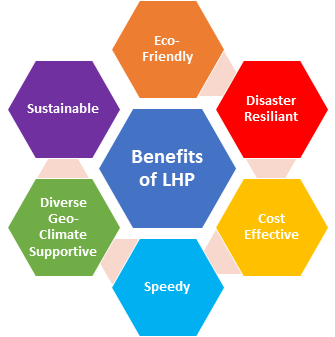
- Global Housing Technology Challenge – India (GHTC- India)
- The Ministry of Housing and Urban Affairs has conceptualized a GHTC- India.
- Aims:
- To identify and mainstream a basket of innovative technologies from across the globe that are sustainable and disaster-resilient.
- To provide an ecosystem for the adoption of innovative technologies in the housing construction sector in a holistic manner.
- GHTC-India leverages the scale and successes of the Pradhan Mantri Awas Yojana (Urban) and its Technology Sub-Mission.
- TECHNOGRAHIS
- TECHNOGRAHIS are students from IITs, NITs, planning, engineering, architectural institutes, as well as faculty members, academics, and stakeholders.
- The Ministry of Housing and Urban Affairs has introduced it (MoHUA).
- Technology Innovation Grants (TIG)
- The Ministry of Housing and Urban Affairs (MoHUA) has developed a Technology Innovation Grant (TIG).
- TIG is a monetary reward given to states in addition to the cash grants provided by PMAY (U).
- NAVARITIH
- NAVARITIH stands for New, Affordable, Validated, Research Innovation Technologies for Indian Housing.
- NAVARITIH is a certificate programme in Innovative Construction Technologies.
Chapter 10: Drone Policy
Introduction:
The Government of India has recently released a new and liberalised Drone Policy. This chapter looks into the Drone Rules 2021.
Drones in India:
- What is a Drone?
- An unmanned aircraft or spacecraft classified as an “unmanned aerial vehicle,” or UAV, is referred to as a drone.
- It is a flying robot that can be remotely controlled utilising software-controlled flight plans in its embedded systems, which work in tandem with onboard sensors and GPS.
- Indian Drone Market:
- January 2020 Report by PwC suggested:
- Market Size in India would be USD 885 million.
- Annual growth of 12.6% between 2020-2026.
- According to Stockholm International Peace Research Institute (SIPRI):
- India is the third-largest importer of military drones.
- January 2020 Report by PwC suggested:
- Indian Government Measures to Encourage Drones:
- Innovations for Defence Excellence (iDEX): The Ministry of Defence (MoD) approved a Rs 498.8 crore grant for its “Innovations for Defence Excellence” indigenisation initiative (iDEX). It is the operating framework of the Defence Innovation Organization (DIO).
- PLI Scheme for Drones and Drone Components: Central government has approved the Production-Linked Incentive (PLI) scheme for drones and drone components.
- Drone Rules 2021: This policy recognises the immense applications of drones and allows the exploration of more liberal regulations.
- India’s Inherent Innovation Potential
- Expansion in geographic and cultural peripheries brings new ideas forward.
- Deep penetration of the internet has allowed Indians to become well acquainted with emerging trends.
- Innovation potential is inherent to the social fabric.
- The easing of regulations by the government has opened international funding.
- India has emerged as a leading destination of Foreign Direct Investment (FDI).
Read more on the Drone Rules, 2021 in the linked article.
Chapter 11: Science Education
Introduction:
This chapter discusses the New Education Policy (NEP) 2020 which makes space for inquiry-based, discovery-based and analysis-based learning.
Schemes for Science Education:
- INSPIRE: “Innovation in Science Pursuit of Inspired Research (INSPIRE)” is a cutting-edge initiative financed and managed by the Department of Science and Technology to attract talent to science.
- MANAK: MANAK (Million Minds Augmenting National Aspirations and Knowledge) aims to motivate students in the age group of 10-15 years and studying in classes 6 to 10. It is being executed by DST with the National Innovation Foundation.
- Vigyan Jyoti: Vigyan Jyoti programme is a new initiative to encourage girls to take interest in science and build careers launched by the Department of Science & Technology (DST).
- Engage with Science: Engage with Science of Vigyan Prasar is an initiative to build interest in science and create a community of practice with students, teachers, and scientists.
- Vidyarthi Vigyan Manthan (VVM): It is an initiative of Vijnana Bharati (VIBHA). VVM is a national program for popularizing science among school students of standard VI to XI.
- Kishore Vaigyanik Protsahan Yojana (KVPY): It is initiated and funded by the Department of Science and Technology to attract exceptionally highly motivated students for pursuing basic science courses and research careers in science.
- National Children’s Science Congress (NCSC): It is a nationwide Science Communication programme started in the year 1993. It is a programme of the National Council for Science and Technology Communication (NCSTC).
- VIPNET: It stands for Vigyan Prasar NETwork which was added as a new project to Vigyan Prasar in 1998. The objective is to provide a fillip to the science clubs movement in India.
- Jigyasa Programme: It is a student-scientist connect programme implemented by the Council of Scientific and Industrial Research (CSIR) in collaboration with Kendriya Vidyalaya Sangathan (KVS). Read more in PIB dated Sep 9, 2020.
Schemes for Science Education:
- Universal Immunization Programme (UIP): The Ministry of Health and Family Welfare, Government of India, started it in 1985 as the ‘Expanded Programme of Immunization’ (EPI). Through the Universal Immunisation Programme, it distributes various vaccinations to infants, children, and pregnant women.
- Intensified Mission Indradhanush (IMI): It was started with the goal of reaching every child under the age of two, as well as all pregnant women who were left out of the standard immunisation program/UIP. Know more about Intensified Mission Indradhanush in the link.
Chapter 12: Nutrition and Vaccination
Introduction:
This chapter describes the significance of nutrition for health and development.
Initiatives on Nutrition:
- Anganwadi Services Scheme: It is a key flagship programme that began in 1975 and offers a package of six services: supplemental nutrition, pre-school non-formal education, nutrition and health education, vaccinations, health checkups, and referral services.
- POSHAN Abhiyan: It was launched in 2018 to deliver a high impact package of interventions for the first 1000 days of life.
- Pradhan Mantri Matru Vandana Yojana: It is a centrally sponsored Direct Benefit Transfer initiative in which Pregnant Women and Lactating Mothers receive a financial incentive of Rs. 5000/- in three instalments.
- Scheme for Adolescent Girls: The Scheme for Adolescent Girls (SAG) is a centrally sponsored programme for adolescent girls aged 11 to 14. SAG targets out-of-school adolescent girls in the above age bracket.
Chapter 13: Tidbits – India in Space
Evolution of India’s Space Program
Benefits of Space Reform for India:
|
Gist of Yojana October 2021:- Download PDF Here
Comments